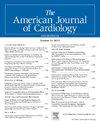Identifying Pathogenesis of Acute Coronary Syndromes using Sequence Contrastive Learning in Coronary Angiography
IF 2.1
3区 医学
Q2 CARDIAC & CARDIOVASCULAR SYSTEMS
引用次数: 0
Abstract
Advances in intracoronary imaging have made it possible to distinguish different pathological mechanisms underlying acute coronary syndrome (ACS) in vivo. Accurate identification of these mechanisms is increasingly recognized as essential for enabling tailored therapeutic strategies. ACS pathogenesis is primarily classified into 2 major types: plaque rupture (PR) and plaque erosion (PE). Patients with PR are treated with intracoronary stenting, whereas those with PE may be potentially managed conservatively without stenting. The aim of this study is to develop neural networks capable of distinguishing PR from PE solely using coronary angiography (CAG). A total of 842 videos from 278 ACS patients (PR:172, PE:106) were included. To ensure the reliability of the ground truth for PR/PE classification, the ACS pathogenesis for each patient was confirmed using Optical Coherence Tomography (OCT). To enhance the learning of discriminative features across consecutive frames and improve PR/PE classification performance, we propose Sequence Contrastive Learning (SeqCon), which addresses the limitations inherent in conventional contrastive learning approaches. In the experiments, the external test set consisted of 18 PR patients (46 videos) and 11 PE patients (30 videos). SeqCon achieved an accuracy of 82.8%, sensitivity of 88.9%, specificity of 72.3%, positive predictive value of 84.2%, and negative predictive value of 80.0% at the patient-level. This is the first report to use contrastive learning for diagnosing the underlying mechanism of ACS by CAG. We demonstrated that it can be feasible to distinguish between PR and PE without intracoronary imaging modalities.
利用冠状动脉造影序列对比学习识别急性冠状动脉综合征的发病机制。
冠状动脉内成像技术的进步使得区分体内急性冠状动脉综合征(ACS)的不同病理机制成为可能。人们越来越认识到,准确识别这些机制对于制定量身定制的治疗策略至关重要。ACS发病机制主要分为斑块破裂(PR)和斑块侵蚀(PE)两大类。PR患者可采用冠状动脉内支架植入术,而PE患者可保守治疗,无需支架植入术。本研究的目的是开发能够仅通过冠状动脉造影(CAG)区分PR和PE的神经网络。共纳入278例ACS患者(PR:172, PE:106)的842段视频。为了确保PR/PE分类的可靠性,使用光学相干断层扫描(OCT)确认每位患者的ACS发病机制。为了增强连续帧间判别特征的学习并提高PR/PE分类性能,我们提出了序列对比学习(SeqCon),该方法解决了传统对比学习方法固有的局限性。在实验中,外部测试集由18例PR患者(46个视频)和11例PE患者(30个视频)组成。SeqCon在患者水平上的准确性为82.8%,敏感性为88.9%,特异性为72.3%,阳性预测值为84.2%,阴性预测值为80.0%。这是第一个使用CAG对比学习诊断ACS潜在机制的报道。我们证明,在没有冠状动脉内成像的情况下,区分PR和PE是可行的。
本文章由计算机程序翻译,如有差异,请以英文原文为准。
求助全文
约1分钟内获得全文
求助全文
来源期刊

American Journal of Cardiology
医学-心血管系统
CiteScore
4.00
自引率
3.60%
发文量
698
审稿时长
33 days
期刊介绍:
Published 24 times a year, The American Journal of Cardiology® is an independent journal designed for cardiovascular disease specialists and internists with a subspecialty in cardiology throughout the world. AJC is an independent, scientific, peer-reviewed journal of original articles that focus on the practical, clinical approach to the diagnosis and treatment of cardiovascular disease. AJC has one of the fastest acceptance to publication times in Cardiology. Features report on systemic hypertension, methodology, drugs, pacing, arrhythmia, preventive cardiology, congestive heart failure, valvular heart disease, congenital heart disease, and cardiomyopathy. Also included are editorials, readers'' comments, and symposia.
 求助内容:
求助内容: 应助结果提醒方式:
应助结果提醒方式:


